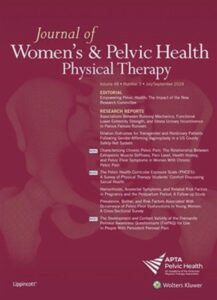Publications

Characterizing Chronic Pelvic Pain: The Relationship Between Extrapelvic Muscle Stiffness, Pain Level, Health History, and Pelvic Floor Symptoms in Women With Chronic Pelvic Pain
Authors: Laurel Proulx 1, Kelli Brizzolara 2, Mary Thompson 2, Sharon Wang-Price 2, Patricia Rodriguez 3, Shane Koppenhaver 1
Affiliations:
- Baylor University, Waco, Texas
- Texas Woman’s University, Dallas, Texas
- Audi Murphy Veteran’s Hospital, San Antonio, Texas
Journal: Journal of Women’s & Pelvic Health Physical Therapy - July 2024, Volume 48, Issue 3, Pages 165-175 (DOI: 10.1097/JWH.0000000000000309)
-
Field & Applications:
- Medical
- Musculoskeletal disorder
- Women's health
Purpose: The purpose of this cross-sectional study was to assess the association of extrapelvic muscular stiffness measures with pelvic floor symptoms and clinical impairments in women with chronic pelvic pain (CPP). In addition to bivariate correlations, exploratory factor analysis (EFA) was used to identify multivariate clinical presentation patterns of CPP.
Methods: Muscle stiffness measurements of 11 extrapelvic muscles were taken in 149 women with CPP. Associations between muscle stiffness and clinical measures such as pelvic floor function, pain, psychosocial status, and urogynecology history were calculated. In addition, variables were assessed using EFA to identify patterns of CPP.
Results: There were small but significant correlations between muscle stiffness measurements and clinical measures. Three categorizations of CPP symptoms and impairments emerged from the 25 continuous variables chosen for EFA. These could be classified as follows: (1) pelvic floor dysfunction and psychosocial involvement; (2) muscle stiffness of the hips and thighs; and (3) muscle stiffness of the low back and abdomen, collectively making up 49.1% of the variance.
Discussion: Stiffness of commonly treated extrapelvic muscles was not strongly correlated to pain level or health history of women with CPP. The first EFA component is consistent with patients routinely seen by pelvic health physical therapists, and the latter components are consistent with those who may benefit initially from orthopedic physical therapy. Further research looking at the relationship of muscle stiffness, pelvic floor function, and movement impairments is needed. EFA may be a starting point to better understand who may be appropriate for orthopedic physical therapy treatment versus specialized pelvic health physical therapy care.
Keywords: exploratory factor analysis, lumbopelvic pain, musculoskeletal, physical therapy, rehabilitation
Extrapelvic muscle stiffness as measured by the MyotonPRO was not strongly correlated to overall self-report pain level. Muscles that are commonly treated by physical therapists in the CPP population have small to moderate correlations to urogynecological health history. Extrapelvic muscle stiffness should not be a prioritized pain-producing impairment when treating CPP unless it is within the area of primary pain. Further research is needed to establish whether increased extrapelvic muscle stiffness plays a role in impaired motor function within this population.
The EFA resulted in 3 components of impairments: (1) increased pelvic floor dysfunction and greater psychosocial involvement; (2) increased muscle stiffness of the hips and thighs; and (3) increased muscle stiffness of the abdominal and lumbar spine. These classifications are a preliminary attempt to improve the ability of first-line practitioners to triage those with CPP to the appropriate physical therapy practitioner based on their clinical presentation and health history in order to improve the efficiency of accessing care. Patients displaying symptoms and impairments consistent with the first component may be most appropriate to be seen by a trained pelvic health physical therapist and multidisciplinary team, while patients displaying symptoms and impairments consistent with the latter 2 components may benefit from the care of a more accessible orthopedic physical therapist.


